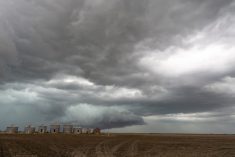A slew of midsummer crop threats including heat, hail and bugs trimmed the potential of Canada’s record-large 2012/13 canola crop, preventing farmers from fully cashing in on high prices, industry analysts say.
On Monday, Statistics Canada lowered its unofficial canola crop yield estimate based on an experimental program that analyzes low-resolution satellite data.
The Crop Condition Assessment Program pegged the average Western Canada canola yield at 33.7 bushels per acre, producing 15.8 million tonnes, compared to its previous estimates of a yield of 34.2 bushels per acre and production of 16.1 million tonnes.
Read Also

Sigurdson applauds Alberta farmers
With Alberta’s harvest virtually wrapped up for 2025, provincial Agriculture Minister RJ Sigurdson offered the government’s congratulations to the province’s farmers.
In Saskatchewan, the biggest canola-growing province, yield reports range wildly from a dismal 15 bushels per acre to more than 50, said Grant McLean, a provincial cropping management specialist at the province’s Agriculture Knowledge Centre in Moose Jaw.
Wet planting conditions in the key east-central Saskatchewan growing region, hail, insects and mid-summer heat and humidity that invited sclerotinia disease all dampened expectations.
The likely outcome is an average to slightly above-average sized crop, in a year farmers were hoping for more, McLean said.
"Part of the disappointment is people were anticipating the high prices and expecting the big bushels," he said. "We were hoping for the double bonanza."
Canada is the biggest producer and exporter of canola, or rapeseed, which is crushed largely for vegetable oil and livestock feed.
ICE Futures Canada’s November canola futures are about $630 a tonne, not far off a four-year high. Prices have remained well-supported in recent weeks largely because of drought damage to U.S. soybeans, but concerns about disappointing Canadian canola yields have also crept into the market, traders said.
Based on its closely watched farmer survey, Statistics Canada last week estimated a Canadian average canola yield of 32.8 bushels per acre, with provincial averages of 30.5 bushels in Saskatchewan, 37.3 bushels in Alberta and 31.4 bushels in Manitoba. It estimated canola production at 15.4 million tonnes.
The harvest is still in the early stages in Alberta, and the extent of disease and insect damage is unclear, said Mark Cutts, a crop specialist for the province’s Ag-Info Centre in Stettler.
"I think a lot of canola fields look quite good. It’s just a matter of when (farmers) get into them, whether they’re going to see disease and insect issues that caused yield loss."
Manitoba’s harvest is the furthest along, and yields will likely settle on average around 30 bushels per acre, said Angela Brackenreed, agronomist for the Canola Council of Canada at Justice, Man. Yield reports range from about 20 to 45 bushels per acre, she said.
Overnight temperatures on most of the western Prairies look to stay well above freezing for the next week, allowing late-planted crops time to develop before a frost — which usually hits by mid-September.
According to StatsCan’s satellite analysis, spring wheat yields in Western Canada look to average 41.1 bushels per acre, with a harvest of 18.9 million tonnes, compared to its previous estimate of 41.5 bushels per acre and production of about 19.1 million tonnes.
— Rod Nickel writes for Reuters from Winnipeg.















